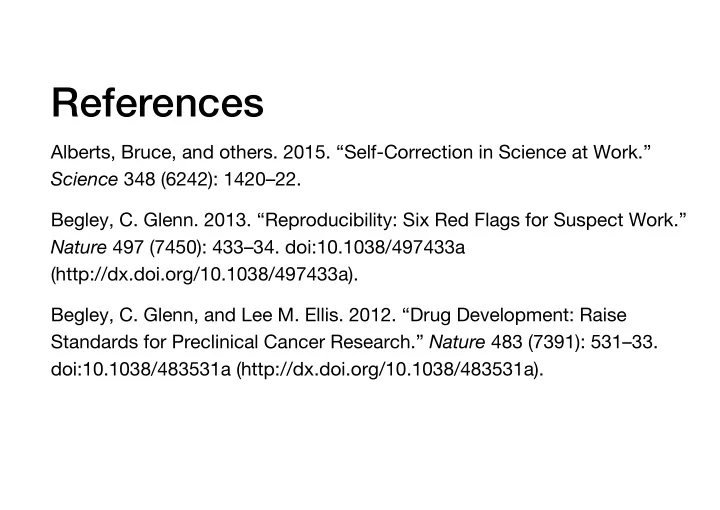

References Alberts, Bruce, and others. 2015. “Self-Correction in Science at Work.” Science 348 (6242): 1420–22. Begley, C. Glenn. 2013. “Reproducibility: Six Red Flags for Suspect Work.” Nature 497 (7450): 433–34. doi:10.1038/497433a (http://dx.doi.org/10.1038/497433a). Begley, C. Glenn, and Lee M. Ellis. 2012. “Drug Development: Raise Standards for Preclinical Cancer Research.” Nature 483 (7391): 531–33. doi:10.1038/483531a (http://dx.doi.org/10.1038/483531a).
Collins, Francis S., and Lawrence A. Tabak. 2014. “Policy: NIH Plans to Enhance Reproducibility.” Nature 505 (7485): 612–13. doi:10.1038/505612a (http://dx.doi.org/10.1038/505612a). COS. 2015. “Center for Open Science (COS).” Cos.io . https://cos.io (https://cos.io). Economist. 2013. “Unreliable Research. Trouble at the Lab.” Economist . http://www.economist.com/news/leaders/21588069-scientific-research- has-changed-world-now-it-needs-change-itself-how-science-goes-wrong (http://www.economist.com/news/leaders/21588069-scientific-research- has-changed-world-now-it-needs-change-itself-how-science-goes-wrong).
Errington, Timothy M, Elizabeth Iorns, William Gunn, Fraser Elisabeth Tan, Joelle Lomax, and Brian A Nosek. 2014. “An Open Investigation of the Reproducibility of Cancer Biology Research.” ELife 3. doi:10.7554/elife.04333 (http://dx.doi.org/10.7554/elife.04333). Fisher, Ronald Aylmer. 1926. “The Arrangement of Field Experiments.” Journal of the Ministry of Agriculture GB 33: 503–13. ———. 1937. The Design of Experiments . 2nd ed. Oliver; Boyd. ———. 1956. Statistical Methods and Scientific Inference . Hafner. Ioannidis, John P. A. 2005. “Why Most Published Research Findings Are False.” CHANCE 18 (4): 40–47. doi:10.1080/09332480.2005.10722754 (http://dx.doi.org/10.1080/09332480.2005.10722754).
Iorns, Elizabeth, and others. 2015. “Validation by Science Exchange - Identifying and Rewarding High-Quality Research.” Validation.scienceexchange.com . http://validation.scienceexchange.com/⧵# (http://validation.scienceexchange.com/⧵#). Kaiser, Jocelyn. 2015. “The Cancer Test.” Science 348 (6242): 1411–13. King, Gary. 2013. “Restructuring the Social Sciences: Reflections from Harvard’s Institute for Quantitative Social Science.” PS: Political Science & Politics 47 (01): 165–72. doi:10.1017/s1049096513001534 (http://dx.doi.org/10.1017/s1049096513001534). Klein, Richard A., and others. 2014. “Investigating Variation in Replicability.” Social Psychology 45 (3): 142–52. doi:10.1027/1864- 9335/a000178 (http://dx.doi.org/10.1027/1864-9335/a000178).
Kriegeskorte, Nikolaus, W Kyle Simmons, Patrick S F Bellgowan, and Chris I Baker. 2009. “Circular Analysis in Systems Neuroscience: The Dangers of Double Dipping.” Nature Neuroscience 12 (5): 535–40. doi:10.1038/nn.2303 (http://dx.doi.org/10.1038/nn.2303). Nosek, B A, and others. 2015. “Promoting an Open Research Culture.” Science 348 (3242): 1422–25. Nuzzo, Regina. 2014. “Scientific Method: Statistical Errors.” Nature 506 (7487): 150–52. doi:10.1038/506150a (http://dx.doi.org/10.1038/506150a). OSBR. 2015. “The Synaptic Leap: Open Source Biomedical Research.” http://www.thesynapticleap.org/ (http://www.thesynapticleap.org/).
OSC. 2015. “Estimating the Reproducibility of Psychological Science.” Science 349 (6251): aac4716–16. doi:10.1126/science.aac4716 (http://dx.doi.org/10.1126/science.aac4716). Pentland, Alex. 2014. Social Physics . Scribe. Prinz, Florian, Thomas Schlange, and Khusru Asadullah. 2011. “Believe It or Not: How Much Can We Rely on Published Data on Potential Drug Targets?” Nature Reviews Drug Discovery 10 (9): 712–12. doi:10.1038/nrd3439-c1 (http://dx.doi.org/10.1038/nrd3439-c1). Scherr, George. 1983. The Best of the Journal of Irreproducible Results: Improbable Investigations and Unfounded Findings . Workman Publishing Company.
Sellke, Thomas, M. J Bayarri, and James O Berger. 2001. “Calibration of P- Values for Testing Precise Null Hypotheses.” The American Statistician 55 (1): 62–71. doi:10.1198/000313001300339950 (http://dx.doi.org/10.1198/000313001300339950). Todd, Mat, and others. 2015. “OSM - Open Source Malaria.” Opensourcemalaria.org . http://opensourcemalaria.org/ (http://opensourcemalaria.org/). Tukey, John. 1997. “More Honest Foundations for Data Analysis.” Journal of Statistical Planning and Inference 57 (1): 21–28. doi:10.1016/s0378- 3758(96)00032-8 (http://dx.doi.org/10.1016/s0378-3758(96)00032-8). Yong, Ed. 2012. “Replication Studies: Bad Copy.” Nature 485 (7398): 298– 300. doi:10.1038/485298a (http://dx.doi.org/10.1038/485298a).
Recommend
More recommend